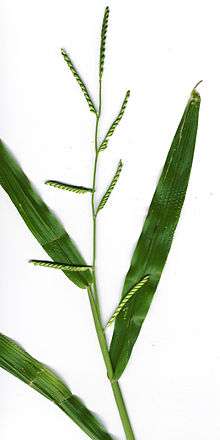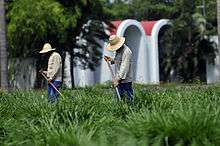Brachiaria
Brachiaria, or signalgrass, is a genus of plants in the grass family native to tropical and subtropical regions of Asia, Africa, Australia, southern Europe, the Americas, and various islands.[4] There are over 100 species.[4][5][6]
| signalgrass | |
|---|---|
 | |
| Brachiaria plantaginea | |
| Scientific classification | |
| Kingdom: | |
| (unranked): | |
| (unranked): | |
| (unranked): | |
| Order: | |
| Family: | |
| Genus: | Brachiaria (Trin.) Griseb., 1853 |
| Type species | |
| Brachiaria eruciformis | |
| Synonyms[2][3] | |
| |
Some species are cultivated as forage. Some species of Brachiaria were probably first introduced unintentionally to the Americas in the colonial period, from slave ships. B. decumbens was introduced to Brazil in 1952 and B. ruziziensis in the 1960s. Brachiaria is the most widely used tropical grass in Central and South America, with about 40 million hectares planted in Brazil alone.[7]
Biology
This genus was described in 1853. It is similar to Panicum, and some authors believe Panicum is ancestral to it.[7] It has also been confused with Urochloa,[8] and sometimes combined with it.[4] A recent phylogenetic analysis concluded that Brachiaria and Urochloa are a monophyletic group, along with Eriochloa and Melinis, and that further molecular and morphological work is needed to establish clear relationships.[8] In the meantime, Brachiaria and Urochloa plants are usually not difficult to distinguish from one another.[4]
Brachiaria are annual or perennial grasses, most lacking rhizomes. The inflorescence is a branching panicle, and the plant reaches about a meter in height.[9] The plants are bisexual[9] and the flowers are fleshy, with 3 anthers.[10] Some species have a prominent vein in the center of the leaf.[9] Brachiaria are C4 species and can tolerate drier conditions and more light exposure than some other plants.[9]
Ecology and conservation

Brachiaria can grow in many environments, from swamps to shady forest to semidesert, but generally do best in savannas and other open tropical ecosystems such as in East Africa.[8] In Angola, B. brizantha grows on termite mounds and in the ecotone between grassland and woodland habitat.[11] In the Kora National Reserve in Kenya, Brachiaria dominates the ground layer along with Aristida.[12] In India, the native B. ramosa is an important food source for the Eurasian collared dove (Streptopelia decaocto) and Brachiaria species are forage for other local herbivores.[13]
In North America, the native B. platyphylla, broadleaf signalgrass, grows after heavy rains and then reproduces prodigiously and quickly, sometimes becoming a weed.[14]
Wide expanses of the tropics, especially the Neotropics, have been converted to Brachiaria pasture to support livestock. In Brazil, 80 million hectares of native habitat have been planted with African grasses, mostly Brachiaria.[15]
Introduced species such as Brachiaria grasses can degrade habitat and compete with native species. In Northern Australia, the exotic B. decumbens competes with the native tree Alphitonia petriei by inhibiting the growth of seedlings, slowing the conversion of abandoned pastureland to natural forest.[16] In the Paragominas area of Brazil, however, native forest outcompetes cultivated stands of Brachiaria and other exotic forage grasses, and ranchers struggle to maintain pasture cover.[17] Native species may also utilize exotic Brachiaria as a food resource, such as the rock cavy (Kerodon rupestris), a native rodent of the caatinga.[18]
Cultivation

Brachiaria is the single most important genus of forage grass for pastures in the tropics.[18] Brachiaria cultivars can grow in infertile and acidic soils.[18] Brazil is the leading user and producer of Brachiaria seeds in the Americas.[18]
Mexico has put effort into improving its trade in Brachiaria cultivars, and the grass is thought to have made a positive impact on its milk and beef industries.[19] Central American countries have also increased seed sales and area planted in the grass.[19] The annual growth rate of seed sales in 2009 was 32% in Mexico, 62% in Honduras, 45% in Nicaragua, 39% in Costa Rica, and 54% in Panama. The area planted with Brachiaria during this period was about 6.5% of the total surface of permanent grasses in Mexico, 12.5% in Honduras, 1% in Nicaragua, 18.7% in Costa Rica, and 0.1% in Panama.[19]
Agricultural pests of Brachiaria include spittlebugs,[20] leafcutter ants, and mound-building termites.[10]
Diversity
- Brachiaria adspersa
- Brachiaria advena
- Brachiaria albicoma
- Brachiaria ambigens
- Brachiaria antsirabensis
- Brachiaria argentea
- Brachiaria arida
- Brachiaria arizonica
- Brachiaria arrecta
- Brachiaria atrisola
- Brachiaria bemarivensis
- Brachiaria benoistii
- Brachiaria bovonei
- Brachiaria breviglumis
- Brachiaria brevispicata
- Brachiaria brizantha
- Brachiaria burmanica
- Brachiaria capuronii
- Brachiaria chusqueoides
- Brachiaria ciliatissima
- Brachiaria clavipila
- Brachiaria comata
- Brachiaria coronifera
- Brachiaria decaryana
- Brachiaria decumbens
- Brachiaria deflexa
- Brachiaria dictyoneura
- Brachiaria dimorpha
- Brachiaria distachya
- Brachiaria distachyoides
- Brachiaria dura
- Brachiaria echinulata
- Brachiaria eminii
- Brachiaria epacridifolia
- Brachiaria eruciformis
- Brachiaria falcifera
- Brachiaria fasciculata
- Brachiaria foliosa
- Brachiaria fragrans
- Brachiaria fruticulosa
- Brachiaria fusiformis
- Brachiaria gilesii
- Brachiaria glomerata
- Brachiaria grossa
- Brachiaria holosericea
- Brachiaria humbertiana
- Brachiaria humidicola
- Brachiaria jaliscana
- Brachiaria jubata
- Brachiaria kurzii
- Brachiaria lachnantha
- Brachiaria lactea
- Brachiaria lata
- Brachiaria lateritica
- Brachiaria leandriana
- Brachiaria leersioides
- Brachiaria leucacrantha
- Brachiaria lindiensis
- Brachiaria longiflora
- Brachiaria lorentziana
- Brachiaria malacodes
- Brachiaria marlothii
- Brachiaria megastachya
- Brachiaria mesocoma
- Brachiaria meziana
- Brachiaria mollis
- Brachiaria multiculma
- Brachiaria munae
- Brachiaria mutica
- Brachiaria nana
- Brachiaria nigropedata
- Brachiaria nilagirica
- Brachiaria notochthona
- Brachiaria oblita
- Brachiaria occidentalis
- Brachiaria oligobrachiata
- Brachiaria ophryodes
- Brachiaria orthostachys
- Brachiaria ovalis
- Brachiaria paucispicata
- Brachiaria perrieri
- Brachiaria piligera
- Brachiaria plantaginea
- Brachiaria platynota
- Brachiaria platyphylla
- Brachiaria polyphylla
- Brachiaria praetervisa
- Brachiaria psammophila
- Brachiaria pseudodichotoma
- Brachiaria pubescens
- Brachiaria pubigera
- Brachiaria pungipes
- Brachiaria ramosa
- Brachiaria remota
- Brachiaria reptans
- Brachiaria reticulata
- Brachiaria rugulosa
- Brachiaria ruziziensis
- Brachiaria scalaris
- Brachiaria schoenfelderi
- Brachiaria semiundulata
- Brachiaria semiverticillata
- Brachiaria serpens
- Brachiaria serrata
- Brachiaria serrifolia
- Brachiaria stefaninii
- Brachiaria stigmatisata
- Brachiaria subquadripara
- Brachiaria subrostrata
- Brachiaria subulifolia
- Brachiaria tanimbarensis
- Brachiaria texana
- Brachiaria tsiafajavonensis
- Brachiaria turbinata
- Brachiaria umbellata
- Brachiaria umbratilis
- Brachiaria urochlooides
- Brachiaria urocoides
- Brachiaria uzondoiensis
- Brachiaria villosa
- Brachiaria whiteana
- Brachiaria windersii
- Brachiaria wittei
- Brachiaria xantholeuca
- Formerly included[2]
See Acroceras, Echinochloa, Eriochloa, Panicum, Paspalum, Urochloa.
- Brachiaria ambigua = Urochloa glumaris
- Brachiaria bulawayensis = Urochloa oligotricha
- Brachiaria callopus = Echinochloa callopus
- Brachiaria capuronii = Panicum comorense
- Brachiaria comorensis = Panicum comorense
- Brachiaria decaryana = Panicum comorense
- Brachiaria digitarioides = Panicum hemitomon
- Brachiaria glabrinodis = Paspalum glabrinode
- Brachiaria grossaria = Paspalum variabile
- Brachiaria hubbardii = Acroceras hubbardii
- Brachiaria karumiensis = Eriochloa succincta
- Brachiaria longifolia = Echinochloa colona
- Brachiaria obtusa = Hopia obtusa
- Brachiaria obtusiflora = Echinochloa rotundiflora
- Brachiaria paspaloides = Urochloa glumaris
- Brachiaria rovumensis = Eriochloa rovumensis
- Brachiaria sadinii = Panicum sadinii
- Brachiaria setigera = Urochloa setigera
- Brachiaria squarrosa = Panicum peteri
- Brachiaria stipitata = Echinochloa callopus
- Brachiaria stolonifera = Urochloa mosambicensis
- Brachiaria tatianae = Rupichloa acuminata
- Brachiaria venezuelae = Panicum venezuelae
See also
References
- Grisebach, August Heinrich Rudolf. 1853. In C.F.von Ledebour (editor), Flora Rossica; sive, Enumeratio plantarum in totius Imperii Rossici provinciis Europaeis, Asiaticis et Americanis hucusque observatarum 4(14): 469 in Latin
- Tropicos, Brachiaria (Trin.) Griseb.
- Kew World Checklist of Selected Plant Families
- Flora of China Vol. 22 Page 520 臂形草属 bi xing cao shu Brachiaria (Trinius) Grisebach, Ledebour, Fl. Ross. 4: 469. 1853. Flora of China.
- Utsunomiya, KS; Pagliarini, MS; Do Valle, CB (2005). "Microsporogenesis in tetraploid accessions of Brachiaria nigropedata (Ficalho & Hiern) Stapf (Gramineae)". Biocell. 29 (3): 295–301. PMID 16524251.
- Mendes-Bonato, AB; Risso-Pascotto, C; Pagliarini, MS; Valle, CB (2006). "Chromosome number and meiotic behaviour in Brachiaria jubata (Gramineae)" (PDF). Journal of Genetics. 85 (1): 83–7. doi:10.1007/BF02728976. PMID 16809846.
- Kumble, Vrinda (1996). Brachiaria: Biology, Agronomy, and Improvement. CIAT.
- Torres González, A.M.; Morton, C.M. (2005). "Molecular and morphological phylogenetic analysis of Brachiaria and Urochloa (Poaceae)". Molecular Phylogenetics and Evolution. 37 (1): 36–44. doi:10.1016/j.ympev.2005.06.003. PMID 16039145.
- Watson, L. and M. J. Dallwitz. (2008). Brachiaria. Archived January 15, 2013, at the Wayback Machine The Grass Genera of the World. Retrieved 7 November 2011.
- Clayton, W. D., et al. (2002 onwards). Brachiaria. GrassBase - The Online World Grass Flora.
- Estes, R. D. and R. K. Estes. (1974). The biology and conservation of the giant sable antelope, Hippotragus niger variani Thomas, 1916. Proceedings of the Academy of Natural Sciences of Philadelphia 126, 73-104.
- Alibhai, S. K.; Key, G. (2009). "A preliminary investigation of small mammal biology in the Kora National Reserve, Kenya". Journal of Tropical Ecology. 1 (4): 321–7. doi:10.1017/S0266467400000407. JSTOR 2559449.
- Rana, B. D. (1975). "Breeding Biology of the Indian Ring Dove in the Rajasthan Desert". The Auk. 92 (2): 322–32. doi:10.2307/4084560. JSTOR 4084560.
- Burke, Ian C.; Thomas, Walter E.; Spears, Janet F.; Wilcut, John W. (2003). "Influence of environmental factors on broadleaf signalgrass (Brachiaria platyphylla) germination". Weed Science. 51 (5): 683–9. doi:10.1614/0043-1745(2003)051[0683:IOEFOB]2.0.CO;2. JSTOR 4046547.
- Boddey, R.M.; MacEdo, R.; Tarré, R.M.; Ferreira, E.; De Oliveira, O.C.; De p. Rezende, C.; Cantarutti, R.B.; Pereira, J.M.; Alves, B.J.R.; Urquiaga, S. (2004). "Nitrogen cycling in Brachiaria pastures: The key to understanding the process of pasture decline". Agriculture, Ecosystems & Environment. 103 (2): 389–403. doi:10.1016/j.agee.2003.12.010.
- Sun, Dan; Dickson, Geoff R. (1996). "The Competition Effect of Brachiaria decumbens on the Early Growth of Direct-Seeded Trees of Alphitonia petriei in Tropical North Australia". Biotropica. 28 (2): 272–6. doi:10.2307/2389082. JSTOR 2389082.
- Nepstad, D. C.; Uhl, C.; Serrao, E.A.S. (1991). "Recuperation of a degraded Amazonian landscape: Forest recovery and agricultural restoration". Ambio. 20 (6): 248–55.
- Singh, R. J. (ed.). "Forage Crops". Genetic Resources, Chromosome Engineering, and Crop Improvement. Florida: CRC Press. p. 209.
- Holmann, F., et al. (2004). Impact of the adoption of Brachiaria grasses: Central America and Mexico. Livestock Research for Rural Development 16, Art. #98.
- McGregor, John T.; Smith, Roy J.; Talbert, Ronald E. (1988). "Broadleaf Signalgrass (Brachiaria platyphylla) Duration of Interference in Rice (Oryza sativa)". Weed Science. 36 (6): 747–50. JSTOR 4044781.
- The Plant List search for Brachiaria